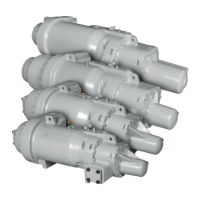31
5.3.4 Slide Valve Capacity Control
The CCM will have the ability to control the compressor
slide valve for capacity control by loading/unloading the
compressor to maintain the refrigeration system's pro-
cess control set point. The set point can be defined in
one of two ways: refrigerant suction pressure (psig) or a
leaving water temperature (deg. F). The end user will
have to configure the CCM in
the following way:
1. Select Pressure or Temperature for the process con-
trol variable (default is Pressure).
2. Select Physical Input or Network Input (Network
Input means the process control variable is not phys-
ically wired to the CCM, but the value is being passed
via the network to the CCM as an input).
3. Input the process control set point value.
• Allowable pressure range is -1.5 psig to 70 psig
(-0.1 bar to 4.8 bar).
• Allowable temperature range is -60°F to 80°F
(-51°C to 27°C).
4. Steps 1, 2, 3 can be accomplished through
:
• Using the BACview hand-held display unit.
• Downloading BACview software to a laptop.
• Setting up a communication port between the
CCM and System Controller.
5. The CCM slide valve control logic works with two
upper and two lower dead-bands. The lower and
upper dead- bands are adjustable control inputs to
customize the capacity control algorithm per the
application.
CCM Slide Valve Control Logic
The CCM slide valve control logic works with two upper
and two lower deadbands. The lower and upper dead-
bands are adjustable control inputs to customize
the
capacity control algorithm per the application. The num-
bered phases below correspond with those that appear in
Fig. 27.
1. On Process Point rise above the Upper DB-1 dead-
band, the CCM will energize both unloader coils to
load the compressor and increase capacity until the
process point falls below Upper DB-2.
Slide Valve Coil #1-Energized
Slide Valve Coil #2 -Energized
2. If the Process Point d
ecreases to the Upper DB-2
deadband limit, the CCM will stop the compressor
from loading by de-energizing coil #1, fixing the slide
valve position and keeping the compressor capacity
constant.
Slide Valve Coil #1-De-energized
Slide Valve Coil #2 -Energized
NOTE: As long as the Process Point remains
between the Upper DB-2 and Lower DB-3 deadband
limits, the slide valve will not move, but remain fixed
,
keeping the compressor capacity constant.
Slide Valve Coil #1-De-energized
Slide Valve Coil #2 -Energized
3. If the Process Point continues to fall and reaches the
Lower DB-4 deadband limit, the CCM will de-ener-
gize both unloader coils to unload the compressor
and decrease compressor capacity.
Slide Valve Coil #1-De-energized
Slide Valve Coil #2 -De-energized
4. Both unloader coils will remain De-ene
rgized until the
suction pressure rises to the Lower DB-3 deadband
limit. This will stop compressor unloading, stopping
the slide valve from moving and keeping the com-
pressor capacity constant.
Slide Valve Coil #1-De-energized
Slide Valve Coil #2 -Energized

